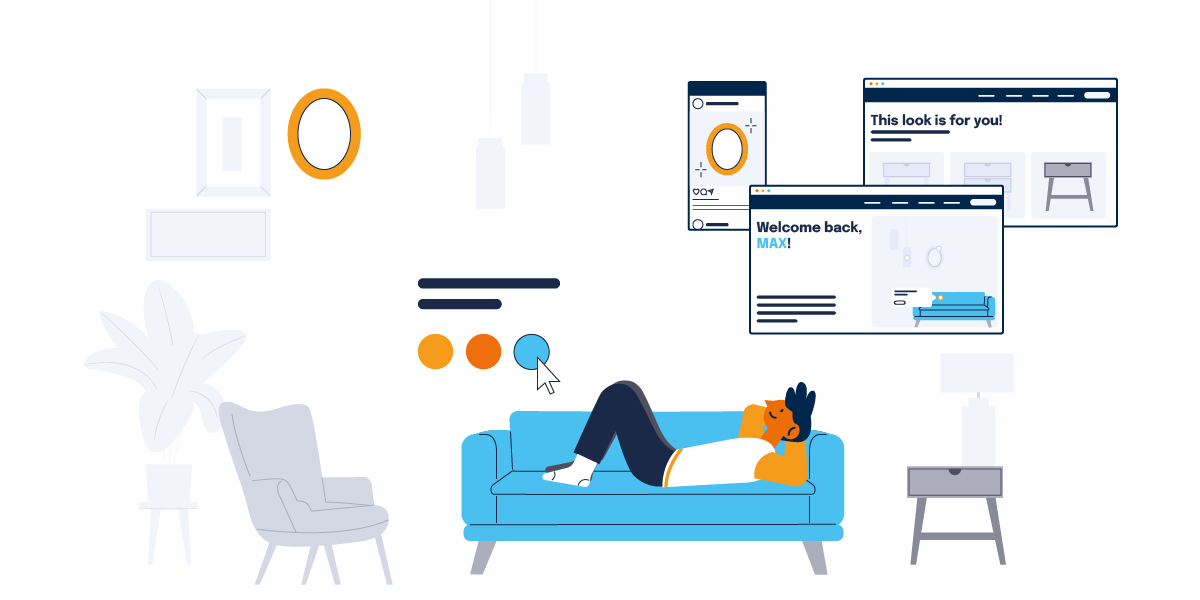The holiday season is over and a new year has begun. Now is the perfect time to convince your customers to shop at your online shop. Cash or gift certificates are often given as Christmas gifts, and that’s exactly what people want to buy now. We have put together three tips on how you, as an online retailer for home and living, can adapt your online shop to the needs of your users and convince them to make a purchase.
Tip 1: Personalize your home page and user interface
Your existing customers are not satisfied with a one-size-fits-all approach. They want personalized content tailored to their interests. The same goes for the overall shop interface to make shopping as easy as possible. For your online shop, this means first and foremost a personalized home page, because that is where most customers start. Relevant offers should be visible at a glance. If the user likes a particular style – boho, for example – you can present new items or products on sale right on the homepage. If it is a particular season, such as Christmas or Easter, and your customer orders new decorations every year, you can also provide your users with a special landing page with all the decorations and display it prominently on the homepage or in the menu. A general rule of thumb for your shop’s menu is to move categories that are relevant to your customers to the top of the menu, while moving categories that are of less interest to them to the bottom of the menu. This makes it easier for them to find the products they want.
Of course, you can also target unknown customers directly on the home page. For example, show your best sellers, the home decor landing page, or the sale, and highlight them in your menu. That way, every customer is guaranteed to see them.
Tip 2: Personalized product recommendations and inspiration pages
Your users are often looking for a very specific product. Whether it’s a new slipcover for the couch, a new set of Christmas tree ornaments, or a new chair for the living room, if they can’t find what they’re looking for, they’ll look elsewhere. Another scenario is that the customer is still unsure of what to buy and is looking for inspiration. Overwhelmed by the sheer number of choices, they will abandon the purchase in frustration.
To prevent this, it is important to show product recommendations, alternatives and inspiration. The best way to do this is to create dedicated landing pages.. Many retailers in the home & living sector have already jumped on the bandwagon and offer inspiration in their online shop with “shop-the-look” pages. These show individual products in combination with other products from the shop – for example, different decorations for a particular occasion. The user can get a better idea of how the items will look together. All items can be added to the shopping cart with a single click. If they don’t like an item, or it’s out of stock, similar-looking alternatives help. Before you know it, you have a whole bunch of products in your cart – not just the one you planned.
Recommendations can also be helpful on product detail pages. In fact, they are essential to a successful online shop. Especially when users come to a product detail page via search engines and are not yet familiar with your shop, it is important to keep them on the page. If they don’t like the product, they will return to the search engine and you will have lost valuable potential customers. You can use different logic for product recommendations on your product detail pages. For example, items that other customers have purchased in conjunction with the product in question. Of course, if you already know the user, you can also show alternatives based on their interests.
Tip 3: Use Social Media for Personalization
Social media is not only a great way to get more exposure, it also allows your business to learn more about your customers and their interests. When you decide to share campaigns on social media, make sure you extend them to your website. There’s nothing more annoying than losing a potential customer just because they can’t find the item or campaign they’re looking for on your website. For example, if you’re running a contest to win a cozy balcony suite and a user wants to enter, they should be able to find it right away. By entering, you now know that the customer has a balcony and can target them in a personalized way thanks to the data they had to leave to enter.
Tip 4: Guided Selling combined with personalization
Guided selling has proven to be an effective way to improve the user experience. This is mainly due to the fact that users are assisted in their search. This guidance can be provided by chatbots, for example, or by digital advisors in the form of questionnaires (wizards). Especially for products with a very large selection, wizards can guide users to the right item by narrowing down the product selection step by step. In addition, you can later use the identified products to highlight them on your category pages. This makes the shopping experience easier for your customers and gives them the feeling of being well advised.
Conclusion
With personalization, you can give your users an individualized shopping experience. This not only increases customer satisfaction, but also promotes long-term loyalty to your company. Personalization is no longer optional, it is now expected by your users. So don’t hesitate to personalize your online shop. Want more tips on personalization? Then our whitepaper “Amazon knows best” is for you!
